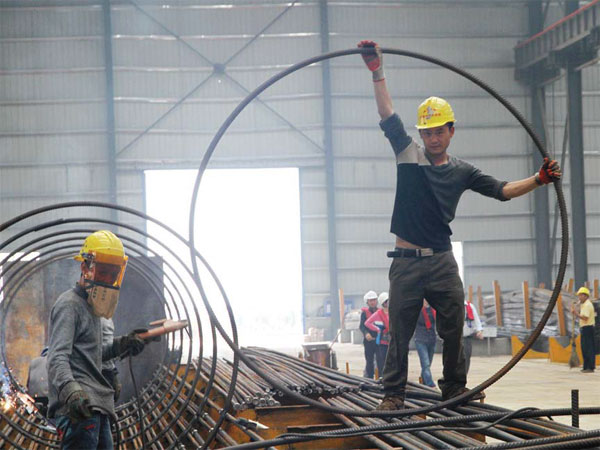Economy still on the right track
China has enough policy tools to offset the major downside risks, according to top officials
Top economic officials have reiterated in the past few days that China's economy is on the right track and well poised to withstand the downward risks and a bearish capital market.
Premier Li Keqiang told a group of overseas Chinese on July 6 in Beijing that the government had the confidence and ability to deal with the risks and challenges faced by its economy, according to a statement on the central government's website.
|
Workers at a bridge construction site in Pingtan, Fujian province. The government has accelerated the approval of infrastructure projects in the hope of boosting sluggish fixed-asset investment. Sun Qizhong / For China Daily |
Major economic indicators have stabilized and positive signs are emerging in the world's second-largest economy, Li said, adding that China's performance during the first six months of the year had been reasonable.
No mention was made of the capital market despite an extraordinary weekend of policy intervention to stabilize the bourses, which have slumped by about 30 percent since mid-June.
Li's comments came on the same day that the country's statistics bureau said the economy showed positive changes and growth was basically stable.
Multiple economic indicators in recent months suggested the economy has passed the worst period and pro-growth and reform measures are taking effect, Sheng Laiyun, spokesman for the National Bureau of Statistics, said in remarks published on its website.
"Positive changes are occurring due to government policies and reform measures. ... The economic structure has continued to improve with the high-tech sector accounting for a major portion of the nation's industrial output, while the services industry is witnessing a rapid growth in investment," Sheng said.
The statement assumes importance as it comes just ahead of the second-quarter data, including GDP growth, which will be published by the NBS on July 15.
NBS officials routinely make such public briefings before major data announcements to shape public and market sentiment. Sheng cited only data till May to illustrate his points. But it is widely believed that officials have the actual Q2 data in mind when they speak.
The official Manufacturing Purchasing Managers Index, a key measure of factory activity in China, stood at 50.2 in June, unchanged from May. Market consensus is GDP growth will be about 7 percent in the second quarter, unchanged from the first quarter.
Meanwhile, the government has stepped up its efforts to bolster economic growth, especially investment. The central bank cut the benchmark interest rate by 0.25 percentage point in late June and lowered the reserve requirement ratio for targeted banks.
Authorities have also accelerated the approval of infrastructure projects in the hope of boosting the sluggish fixed-asset investment. The National Development and Reform Commission had until July 1 approved infrastructure projects with a combined investment of 884 billion yuan ($142.37 billion) this year, with the urban mass-transit systems accounting for the largest share.
Zhu Guangyao, vice-minister of finance, told China Economic Weekly, a newspaper affiliated with the People's Daily, that China could expand its fiscal deficit in the second half to make the "proactive fiscal policy" more "proactive".
China at the beginning of the year raised its deficit target from 2.1 percent of GDP in 2014 to 2.3 percent, or 1.62 trillion yuan.



















